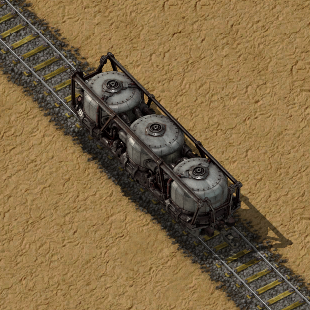Fluid wagon: Difference between revisions
m (→History: minor tweak) |
(Reordering with 1.1) |
||
| (3 intermediate revisions by 2 users not shown) | |||
| Line 8: | Line 8: | ||
To get fluid into the fluid wagon, you need a [[Railway#Stations|train station]] with pumps. | To get fluid into the fluid wagon, you need a [[Railway#Stations|train station]] with pumps. | ||
The wagon needs to be aligned with the rail grid; do this by using | The wagon needs to be aligned with the rail grid; do this by using a [[train stop]] as a [[Railway#Train_schedule|train schedule]] destination, and a fueled locomotive. | ||
Also make sure that the [[rail]]s under the Fluid wagon are '''straight rails''' and not '''curved rails'''. The pumps will only work if the wagon is perfectly orthogonal to the grid. | Also make sure that the [[rail]]s under the Fluid wagon are '''straight rails''' and not '''curved rails'''. The pumps will only work if the wagon is perfectly orthogonal to the grid. | ||
| Line 18: | Line 18: | ||
Testing was done using a single locomotive attached to a single full fluid wagon, with pumps attached directly to empty storage tanks. Using this test setup: | Testing was done using a single locomotive attached to a single full fluid wagon, with pumps attached directly to empty storage tanks. Using this test setup: | ||
* Using 1 pump, the train remained in station for | * Using 1 pump, the train remained in station for 204 ticks (3.4 seconds) | ||
* Using 2 pumps, the train remained in station for | * Using 2 pumps, the train remained in station for 131 ticks (~2.2 seconds) | ||
* Using 3 pumps, the train remained in station for | * Using 3 pumps, the train remained in station for 108 ticks (1.8 seconds) | ||
== History == | == History == | ||
| Line 38: | Line 38: | ||
{{LogisticsNav}} | {{LogisticsNav}} | ||
{{C| | {{C|Railway}} | ||
{{C|Rolling stock}} | |||
Latest revision as of 15:31, 19 March 2021
| Fluid wagon |
|
Recipe |
|
| + + + + → | |
|
Total raw |
|
| + + |
|
Recipe |
|
| + + + + → | |
|
Total raw |
|
| + + |
|
Map icon |
|
|
Fluid storage volume |
25000 |
|
Health |
600 |
|
Resistances |
Acid: 3/20% |
|
Stack size |
5 |
|
Dimensions |
2×6 |
|
Mining time |
0.5 |
|
Weight |
1000 |
|
Prototype type |
|
|
Internal name |
fluid-wagon |
|
Required technologies |
|
|
Boosting technologies |
|
|
Produced by |
|
The fluid wagon, also known as the rail tanker, is capable of transporting fluids by rail. Fluids can be pumped in and out of the wagon using a pump, each fluid wagon can have a maximum of 3 pumps attached at one time, 1 per tank section. Similar to cargo wagons, a locomotive is required to move the liquid wagon.
The fluid wagon can carry 25,000 units of fluid. It weighs the same of the regular cargo wagon but holds more fluid; a cargo wagon filled with barrels can carry 20,000 units of fluid.
Troubleshooting
To get fluid into the fluid wagon, you need a train station with pumps.
The wagon needs to be aligned with the rail grid; do this by using a train stop as a train schedule destination, and a fueled locomotive.
Also make sure that the rails under the Fluid wagon are straight rails and not curved rails. The pumps will only work if the wagon is perfectly orthogonal to the grid.
Load and unload times
Due to current fluid system mechanics, the fastest load and unload times for fluid wagons consist of pumps that are directly attached to storage tanks. Using more pumps per wagon reduces (un)loading time.
Testing was done using a single locomotive attached to a single full fluid wagon, with pumps attached directly to empty storage tanks. Using this test setup:
- Using 1 pump, the train remained in station for 204 ticks (3.4 seconds)
- Using 2 pumps, the train remained in station for 131 ticks (~2.2 seconds)
- Using 3 pumps, the train remained in station for 108 ticks (1.8 seconds)
History
- 0.16.8:
- Changed fluid wagon capacity from 75k to 25k (same as storage tank).
- Lowered fluid wagon weight from 3000 to 1000 (same as cargo wagon).
- Changed fluid wagon recipe so it requires just 1 storage tank instead of 3.
- 0.16.7:
- Simplified to contain just 1 fluid instead of having 3 different fluid tanks.
- 0.15.0:
- Introduced
